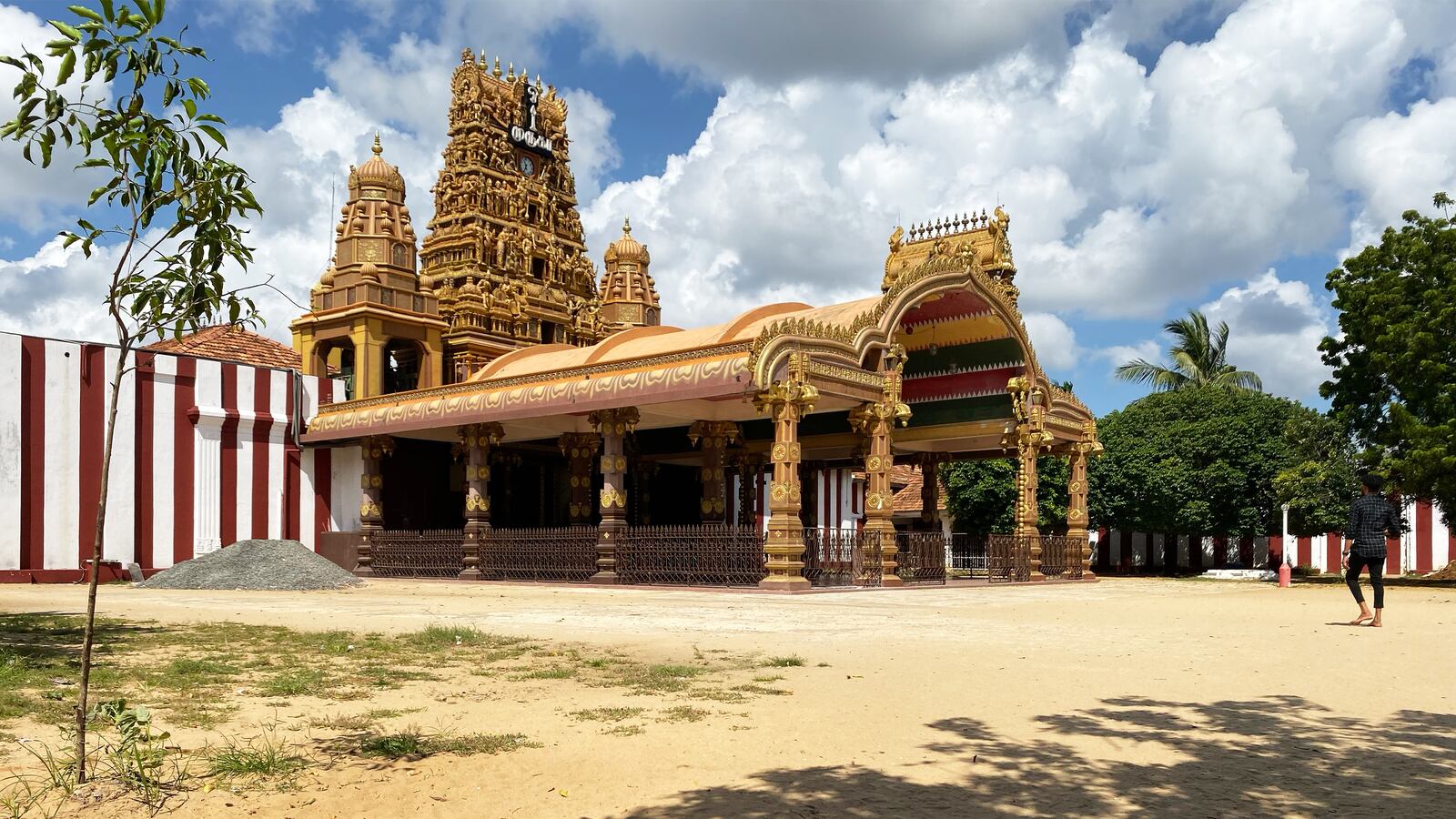This is the latest installment of our twice-a-month series on underrated destinations, It's Still a Big World.
I left my hotel in Jaffna at the golden hour. Off the typical backpacker’s itinerary, this quaint city is the seat of Tamil-Hindu culture in Sri Lanka. From candy cane-colored temples to oversize ice cream parlours, this creative hub offers a peek into Sri Lankan Tamil culture and the island’s colonial history.
Located at the end of Jaffna peninsula, the city’s location—a mere 50 miles from India—made it a key trading post on the Maritime Silk Road. For modern visitors, this translates to a cosmopolitan feel with cuisines, cultures, and architecture from around the world jumbled together.
I was first inspired to go north after reading Nayomi Munaweera’s Island of a Thousand Mirrors. I’d visited country a few times before, working with influencers, boutique hotels, restaurants, and the tourism alliance. And in all the time, Jaffna—which was once the second most important city in Sri Lanka—was never brought up. While other parts of Sri Lanka have been quickly developed in order to accommodate millions of foreign visitors a year, this region was left off the map.
I wanted to know why.
For my first night in Sri Lanka’s northernmost city I headed to the famed Mango’s Indian Veg restaurant. Walking across the train tracks at the station, I dodged women in saris on bikes and men in long trousers cycling as a bakery-on-wheels tuk-tuk played Für Elise. It was quiet but perhaps it was the heat—that day in January registered at over 90 degrees.
I peered into old estates, sneaking peeks of limestone arches, lily ponds, stucco roofs, and foot paths lined with pink jungle geraniums. Stately houses boasted statues of cows atop their gates or lions flanking the entrance. Although British colonial efforts were more concentrated in southern cities like Colombo, the period’s architecture is more evident in Jaffna as the city hasn’t changed much in the past 30 years.
“Jaffna is essentially a port town,” said Aloysious Aousten, a 25-year old local architect who turned his master’s thesis on Jaffna into an Airbnb Experiences tour. We met over breakfast at Valampuri where the millennial explained how during the British colonial period Jaffna traded directly with India—at that time, they weren’t considered to be a different countries. The city’s septuagenarians remember taking the ferry to India to watch movies.
“If you look carefully, you can see the ‘good old Jaffna’… in every layer of development,” said Aousten. “Starting with the Dutch, how it constructed into British, how it was affected by American Modernism, and then how it was affected by the war.”
A strong historical connection to India is seen throughout Jaffna. In addition to being Tamil, a minority ethnic group in Sri Lanka whose lineage historians trace to southern India, they eat the food of Kerala, another medieval kingdom originating from southern India that co-mingled with Sri Lanka over centuries of history.
As I neared Mango’s, I heard the dusk drummers in the distance at the famed Nallur Kandaswamy Kovil temple. It is one of the most important Hindu sites on the tropical island and visitors are encouraged to witness the twice-daily ceremonies at dawn and dusk. Walking by the temple, the streets felt frozen in 19th century time. After a few weeks on the south coast, where well-known fish shacks necessitate long waits, a bit of quiet in Sri Lanka was welcome.
“It is a very rural area but if you walk into a village and talk to the older generation they will be speaking English but chewing the betel leaf” is how Balathasan Sayanthan, the 37-year-old behind Jaffna’s first coding school and coworking space told me. “It’s highly educated but was cut-off and in a way, left behind for 30 years of war, only now catching up.”
As an entrepreneur, he sees the possibilities in the city, pointing out to me the spirituality of Jaffna and the resourcefulness of its residents. A kid in Uki Coding School had built a fire extinguisher robot out of a toy car, an Arduino board, and shaving foam; a woman started a business selling jaggery, a sugar-substitute derived from the region’s renowned Palmyra tree.
At Mango’s, I dined on kottu—a crepe-like pancake that is chopped up and mixed with vegetables, and in this case, paneer (a cheese) which is typically used in southern Indian cuisine. In other parts of the island, I hadn’t seen the cheese added to this dish but it added to the depth of flavor, adding a tang to the scallion, red onion, and carrots. For 400 rupees or $2.21, it was a steal.
Tamils also speak a different language than Singhalese, the majority ethnic group in Sri Lanka. The decades-long civil war was fought over cultural differences, with the Liberation Tamil Tigers of Eelam (LTTE) army seceding from Sri Lanka in 1983, as the Tamil claimed the majority Singhalese were pushing the Tamil population out of opportunities in civil service or education. In practical terms, this meant that the north and east Tamil-majority areas created their own country, effectively cutting themselves off from the rest of Sri Lanka. Connections by bus, rail and highways were discontinued and to this day, remain limited as compared to other regions. Southern separatists also fought, and violence ravaged the country on-and-off for decades until 2009 when the the Sri Lankan military defeated the LTTE in their capital of Kilinochchi. Fought in three major periods interspursed with ceasefires, the 26-year-long war sowed incredible distrust on both sides, as terrorist attacks, disappearances, kidnappings and torture were commonplace for citizens.
In many parts of the country, the war’s legacy isn’t physically evident for visitors, especially in touristic zones. Since the ceasefire, the government has poured money into promoting the tropical island to tourists; it’s a $4.4 billion dollar industry that accounted for 4.9 percent of the country’s GDP (GDP) in 2018. But while the image of a united country is promoted abroad, tensions between the two groups still exist—this month, newly elected President Gotabaya Rajapaksa declined to sing the national anthem in Tamil, a practice which the previous government adhered to.
“In the pre-conflict era, Jaffna had an equal economic contribution to Colombo…with the war, everything stopped,” said Aousten. For the 25-year-old his city’s history lives on around him, in part because he said, it experienced a “30-year gap because of the civil war. It isn’t as improved as Colombo.”
Some feel that the government is intentionally leaving behind the Tamil areas in tourism promotion as they were the ones who tried to secede from the country during the civil war.
“They are making the new victory... which is that foreign people don’t want to look at our culture,” said Sivasubramaniam Kajendran, a Sri Lankan artist who explores themes of memory, grief and identity in his work. He lost family members in the war and afterwards spent nearly a year in an internally displaced persons or IDP camp before going to University of Jaffna to study art. “There are a million people who visit Colombo and the southern part [of the island] but not Jaffna.”
“Rather than developing tourism [the government] put up barriers so the private sector has to develop tourism,” said Sriskantharajah Karthigan, the secretary of the Northern Province Tourism Alliance. He alleges that the government made Jaffna International Airport more difficult and expensive than the one in Negombo, in an effort to curb tourism to the north as India is Sri Lanka’s largest inbound tourism market.
Formed in 2010, the Northern Province Tourism Alliance lobbies the central government in an attempt to change these policies. In addition to the airport, they are petitioning the government to allow boat access to the “Adam’s Bridge,” a chain of limestone islands that run between India and Sri Lanka.
“If there were a connection there would be a higher chance of economic development—that’s why they don’t want it,” said Karthigan. “If we become economically independent they won’t like that.”
This lack of support is evident in many of the touristic sites. I visited Jaffna Fort in the heat of the day, squaring off with languid cows as I drove to the parking lot. The star shaped citadel was mildly crowded when I arrived; later, an employee said that there had been 600 Sri Lankans and 40 foreigners—a pretty typical draw.
While at one point this was the second-most important fort in Ceylon—the British colonial name for Sri Lanka—the crowds were thin and the grounds were not well-maintained, despite a two-year archaeological preservation project that was being funded by The Netherlands.
I almost didn’t make it to Jaffna. When I told a rental car company in Negombo where I was going, they suddenly said I couldn’t rent a car without a driver, although a minute previously they had one available for me.
I found a new rental company and when they asked where I was going, I lied.
Other foreign tourists in Jaffna also found it hard to reach Sri Lanka’s second city in the former rebel-held North. Bus and trains—although an efficient way to travel most of the country—aren’t as frequent as in other parts of the country. Driving was also more constricted than elsewhere in Sri Lanka; I went through at least six security roadblocks on my way north.
Perhaps for now, this inaccessibility can help to preserve the city’s charm. Tourists to Sri Lanka were doubling year-after-year until 2019’s Easter attacks when visitor numbers plummeted to 2009 levels. Most recently, tourist arrivals are nearly back up to pre-attack levels. And many of the popular sites have become checkmarks on a 10-day circuit. Jaffna offers something different.
I stopped by the city’s famous Nallur Kandaswamy Kovil temple, one of the most important Hindu sites in the country. It was surprising that I didn’t have to pay a fee to get in or money for someone to watch my sandals—at other temples in Sri Lanka, tourists can feel decidedly like an income stream.
Instead, I wandered gold-painted rooms with mirror-inlaid columns and evocative murals. A hot wind blew through chimes as the smell of incense mixed with charred wood and coconut. Most of the men were shirtless, wearing the traditional sarong while women also donned the traditional sari. Many pilgrims wore red and had holy white ash on their faces or torsos.
As I left, a woman with a gold and teal sari visiting with her mom and son gave me some of the burned food that was an offering in the Temple; we’d spoken despite not sharing a language.
Taking my sandals, I walked to the road past a few cows and knew that I would be carrying these memories of Jaffna for a long time.






